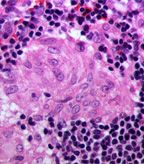Promising Biomarker for HPV-Related Oropharyngeal Cancer
More than one-third of patients with oropharyngeal cancer were seropositive for HPV16 E6 an average of 6 years prior to their cancer diagnosis compared with less than 1% of healthy controls, a new study has found.
More than one-third of patients with oropharyngeal cancer were seropositive for HPV16 E6 an average of 6 years prior to their cancer diagnosis compared with less than 1% of healthy controls, a new study has found. In some cases, patients had seropositivity more than 10 years before their diagnosis with oropharyngeal cancer.

Sarcoid-like lesion (benign epitheloid cell reaction) in a nuchal lymph node in a case of oropharyngeal squamous cell carcinoma; source: Patho, Wikimedia Commons
HPV16 has been linked to a rapid increase in the incidence of oropharyngeal cancers worldwide. Prior research has shown that “antibody markers against HPV E6 and E7 oncoproteins should occur in response to an underlying HPV-driven neoplastic process.” Although multiple studies have validated this theory for HPV E6 antibodies, evidence is less clear for HPV16 E7 antibodies.
Researchers led by Aime R. Kreimer, PhD, of the National Cancer Institute, identified 638 participants with a variety of head and neck cancers, including oral, oropharynx, and hypopharynx/larynx cancers, and 300 patients with esophageal cancers. Pre-diagnostic plasma samples were analyzed for antibodies against HPV oncogenes E6 and E7, and several other types of HPV. Results in patients with cancers were compared with 1,599 control patients. The results were published in the Journal of Clinical Oncology.
Patients who had oropharyngeal cancer had a high adjusted odds ratio of 274 for the diagnosis of subsequent oropharyngeal cancer compared with the healthy controls (95% CI, 110–681). Seropositivity for HPV16 E6 antibodies occurred in 34.8% of patients with oropharyngeal cancer compared with 0.6% of healthy control patients. HPV16 E6 seropositivity was not associated with cancer of other sites.
Similar to prior studies, where results have been unclear, HPV16 E7 seropositivity was found in 11% of healthy control patients. However, 42.6% of patients who had HPV16 E6 positivity also had E7 seropositivity, the researchers found.
“None of the control participants or patients with oral cavity or esophageal cancer were seropositive for both HPV16 E6 and E7, but one patient with laryngeal cancer was dual positive for HPV16 E6 and E7,” the researchers wrote.
Those patients with oropharyngeal cancer who were HPV16 E6 seropositive were more likely to be never-smokers, to have a greater body mass index, and were older at the time of diagnosis. No differences were found between seropositive and seronegative patients for sex, region of Europe, and alcohol consumption.
In addition, patients who were seropositive for HPV E6 had a better prognosis. The 5-year survival was 58% for patients who were seronegative compared with 84% for patients who were seropositive.
“Further quantification of the lead time between HPV16 E6 seroconversion and cancer detection is warranted, to better understand how far in advance testing could occur,” the researchers wrote.
2 Commerce Drive
Cranbury, NJ 08512
All rights reserved.